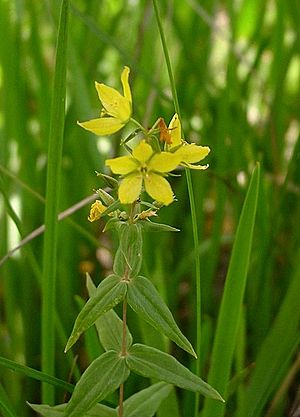Lysimachia asperulifolia facts for kids
Quick facts for kids Lysimachia asperulifolia |
|
|---|---|
 |
|
| Conservation status | |
| Scientific classification | |
| Genus: |
Lysimachia
|
| Species: |
asperulifolia
|
The Lysimachia asperulifolia is a very rare flowering plant. It is also known as the rough-leaved loosestrife or roughleaf yellow loosestrife. This plant is found only in a small area of the Atlantic coastal plain in North Carolina and northern South Carolina in the United States. There are only 64 known groups of these plants left. Because it is so rare, it is listed as an endangered species by the United States government.
What it Looks Like
This plant is a perennial herb, which means it lives for many years. It grows from underground stems called rhizomes. The plant grows straight up, usually about 60 to 70 centimeters (about 2 feet) tall. The lower part of its stem is pinkish and has ridges. The upper part is yellowish and smooth. The stem near the flowers has tiny reddish glands.
Its leaves are green and shaped like a spear, growing up to 5 centimeters long and 2 centimeters wide. They usually grow in groups of three or four around the stem, or sometimes in opposite pairs. Even though its common name is "rough-leaved," the leaves are not rough at all! Near the bottom of the stem, there are smaller, tougher, brown leaves that grow in opposite pairs or in groups of up to seven.
At the top of the stem, you'll find the flowers. They grow in a cluster called a raceme. The flowers are star-shaped and yellow, with green, leaf-like parts called bracts mixed in. Each flower usually has five yellow petals, but sometimes it can have 4 to 7. The petals have wide bases and pointed, jagged tips. Both the petals and the green sepals (which protect the flower bud) have red dots and reddish lines. After the flower blooms, it forms a straw-colored fruit with red spots. This fruit is a small capsule, only a few millimeters long.
Where it Lives
This plant grows in special areas on the coastal plains of North and South Carolina. These areas include pocosins, sandhills, pine flatwoods, and pine savannas. You'll most often find it in open spaces between longleaf pine forests (which are on higher ground) and pond pine pocosins (which are wetlands).
The soil where it grows is often wet or even underwater for parts of the year. It doesn't have many nutrients and is rich in peat (decayed plant matter) over sandy soil. In nature, these areas have openings in thick shrubs. These openings are kept clear by strong, regular wildfires. Fire helps to stop new plants from growing too tall and thick. This allows smaller plants, like the rough-leaved loosestrife, to get enough sunlight and grow well.
Many other plants, trees, and mosses live in these areas. Some trees and shrubs include chokeberry, summersweet, titi, dwarf fothergilla, Appalachian tea, sweetbay, swampbay, and wild blueberries. Some herbs, grasses, and mosses found here are bushy bluestem, wiregrass, sundews, redroot, spoon flower, yellow pitcher plant, and Sphagnum mosses.
In the 1980s, the only healthy groups of this plant were found in the Green Swamp Nature Preserve, the Croatan National Forest, and at Military Ocean Terminal Sunny Point. Another group was at Fort Bragg. To help the red-cockaded woodpecker, a program of controlled fires (called prescribed fire) was started on military lands. These fires also helped the rough-leaved loosestrife. Because of the fires, some new groups of the plant appeared where they had been overgrown by other plants before. For example, new plants grew at Camp Lejeune and more at Fort Bragg. The only group in South Carolina is at Fort Jackson. By 1995, there were 64 known groups.
The plant often reproduces by growing new shoots from its underground rhizomes. This means that what looks like many plants might actually be just a few original plants that have made many copies of themselves (called clones).
Problems it Faces
The biggest danger to the rough-leaved loosestrife is that its home is being lost or damaged. A lot of the land in its region has been developed for homes, factories, and recreation. Wetlands have been drained and dried out, which destroys the plant's natural habitat.
Even the habitat that remains is often not managed correctly. Natural fires, which are important for this plant, are often stopped. When fires are prevented, the pocosins, sandhills, and swamps become overgrown with thick brush and woody plants. These taller plants block the sunlight from reaching the smaller plants on the ground, like the loosestrife. Even when controlled fires are set, they sometimes don't burn enough to clear the thick layers of dead plants that build up. Also, when people create firebreaks (clearings to stop fires), they often plow them in the very areas where this plant grows best.
Agriculture, including planting pine trees for timber, and other activities also change how water flows in the wetlands. This makes the conditions unsuitable for the rough-leaved loosestrife and other native plants. Many of the plant groups are on military bases, which means they could be harmed during military training or operations.


